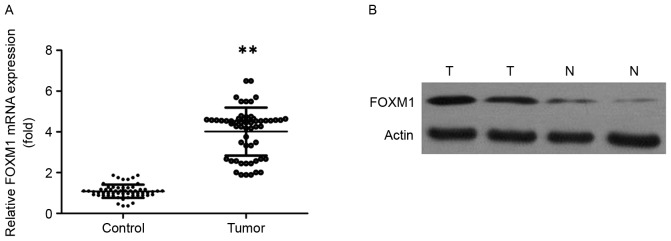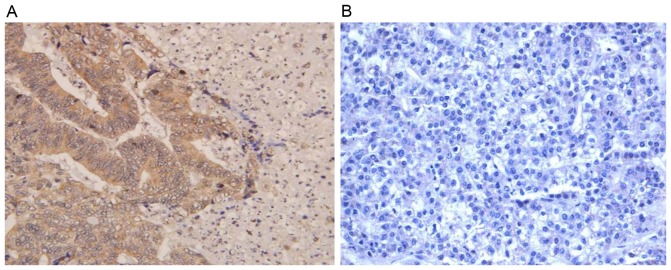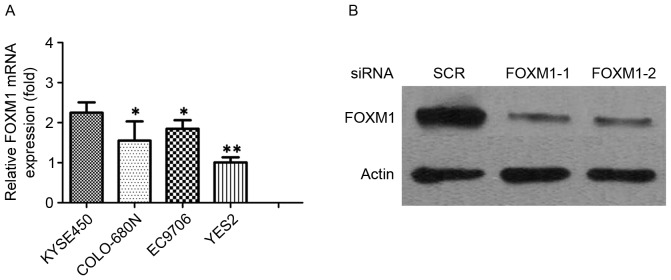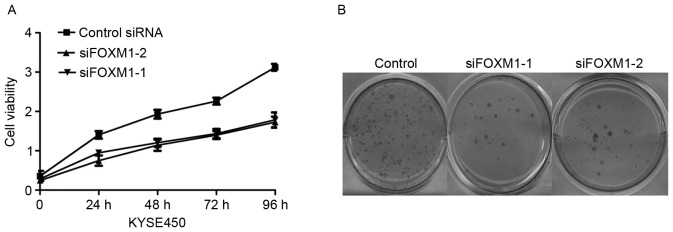Abstract
Esophageal squamous cell carcinoma (ESCC) is one of the most common types of malignancies globally. Forkhead box M1 (FOXM1) has important functions in cancer progression. However, the function of FOXM1 signaling in ESCC remains unknown. The aim of the present study was to evaluate the expression level and function of FOXM1 in human ESCC. The present study first detected the FOXM1 expression level in 78 cases of primary ESCC tissues and matched normal tissue samples by immunohistochemistry, western blot analysis and reverse transcription-quantitative polymerase chain reaction. Subsequently, the present study investigated the impact of FOXM1 knockdown on the ability of cell proliferation and migration of ESCC cells by MTT, clonogenic and Transwell assays. The results revealed that the mRNA and protein expression levels of FOXM1 were upregulated in a series of ESCC tissue samples. Silencing of FOXM1 inhibited the proliferation and migration of ESCC cells. In conclusion, FOXM1 was significantly increased in cancerous tissue samples of patients with ESCC. It may serve as a selective target for the treatment of ESCC.
Keywords: esophageal squamous cell carcinoma, forkhead box protein M1, short interfering RNA, targeted therapy
Introduction
Esophageal squamous cell carcinoma (ESCC) is the predominant histological subtype of esophageal carcinoma, and its highest incidence and mortality rates have been observed in China (1). Due to the high ability of invasion, ESCC has a high mortality rate and extremely poor prognosis, due to insidious symptomatology, late clinical presentation and rapid progression (2). Despite the advancement of diagnostic technologies and therapies, the prognosis for ESCC remains poor, which is largely attributable to the high rates of extensive local invasion and regional lymph node metastasis (3,4). Consequently, improved preventive approaches and more effective treatment modalities are required in order to improve the survival rates of patients with ESCC.
Forkhead box protein M1 (FOXM1) is a member of the FoxM family that consists of >50 proteins characterized by a conserved 100 amino acid DNA binding domain. A previous study also demonstrated that the dysregulation of FOXM1 is involved in a wide range of human cancer subtypes, by functioning as classical oncogenes and having an important function in the initiation, promotion and progression of cancer (5). FOXM1 regulates the expression of a number of targeted genes important to cell proliferation, migration, apoptosis and tumor angiogenesis, suggesting it may have a general function in tumor development and progression. Overexpression of FOXM1 is linked with tumor development in various types of cancer (6–9). Since FOXM1 suppression appears to inhibit tumor progression, chemical compounds targeting FOXM1 may serve as anticancer drugs in different types of tumor; however, the expression of FOXM1 and its function in ESCCs remains unknown.
Materials and methods
Tissue specimens
A total of 78 fresh tumor tissues and paired adjacent non-tumorous tissues were obtained from 78 patients (45 male and 33 female) with ESCC with a median age of 58 (age range 39–71) years who underwent surgery at the Department of Thoracic Surgery, Provincial Hospital Affiliated to Shandong University (Jinan, China) between July 2012 and June 2014. The aforementioned patients were diagnosed with ESCC by a pathologist (Shandong Provincial Hospital affiliated to Shandong University, Jinan, China). The normal paired tissues were obtained from the distal resection margins. All specimens were stored at −80°C until analysis. In addition, the present study collected all the paraffin blocks of the patients to perform immunohistochemical (IHC) staining. No patients received radiotherapy or chemotherapy prior to surgery. The present study was approved by the Research Ethics Committee of Shandong University. Written informed consent was obtained from all patients prior to enrollment in the present study.
Cell culture
ESCC YES2, COLO-680N, EC9706 and KYSE450 cell lines were provided by the Type Culture Collection of the Chinese Academy of Sciences (Shanghai, China). All cell lines were grown in RPMI-1640 supplemented with 10% fetal bovine serum (FBS; Gibco; Thermo Fisher Scientific, Inc., Waltham, MA, USA), 100 µg/µl streptomycin and 100 µg/µl penicillin (pH 7.2–7.4) in a humidified incubator containing 5% CO2 at 37°C.
Reverse transcription-quantitative polymerase chain reaction (RT-qPCR)
Total RNA was extracted from frozen tissues and cell lines using TRIzol reagent (Invitrogen; Thermo Fisher Scientific, Inc.) for 30 min at room temperature. The quality of the RNA was assessed by 1% denaturing agarose gel electrophoresis and spectrophotometry. Complementary DNA (cDNA) was synthesized using a SuperScript VILO cDNA Synthesis kit (Invitrogen; Thermo Fisher Scientific, Inc.). The reaction was incubated in a MyCycler Thermocycler (Bio-Rad Laboratories, Inc., Hercules, CA, USA) for 10 min at 25°C, 60 min at 42°C and 5 min at 85°C. cDNA samples were stored at −20°C prior to RT-PCR amplification. RT-qPCR was performed using the SYBR Green reporter (Takara Biotechnology Co., Ltd., Dalian, China). GAPDH was used as an internal control for each specific gene. A total of three independent experiments were performed to analyze the relative gene expression level and each sample was evaluated in triplicate. The following primers were used: FOXM1 forward, 5′-GCGACAGGTTAAGGTTGAG-3′ and reverse, 5′-AGGTTGTGGCGGATGGAGT-3′; GAPDH forward, 5′-GCACCGTCAAGGCTGAGAAC-3′ and reverse, 5′-TGGTGAAGACGCCAGTGGA-3′. Quantification was performed using the quantitative threshold cycle (Cq) method and efficiency of the RT reaction (relative quantity, 2−ΔΔCq) (10).
Western blot analysis
Total protein was extracted using a lysis buffer and protease inhibitor (Beyotime Institute of Biotechnology, Haimen, China). Equivalent protein amounts (30 µg) were denatured in an SDS sample buffer, and then separated by 10% SDS-PAGE (EMD Millipore, Billerica, MA, USA) and transferred onto a polyvinylidene difluoride membrane. Following blocking with 5% skimmed milk in Tris-buffered saline with 0.1% Tween-20 (pH 7.6) at room temperature for 1 h, the membranes were incubated with primary antibodies at room temperature for 1 h against FOXM1 (1:1,000; cat. no. ab83097; Abcam, Cambridge, UK) and subsequently with a mouse anti-rabbit IgG-horseradish peroxidase (HRP) secondary antibody at room temperature for 1 h (1:5,000; cat. no. BA1003; Boster Biological Technology, Pleasanton, CA, USA). An enhanced chemiluminescent chromogenic substrate was used to visualize the bands and the intensity of the bands was quantified by densitometry (Quantity One software; Bio-Rad Laboratories, Inc., Hercules, CA, USA).
IHC analysis
Primary ESCC tissues and adjacent normal tissues obtained following surgery were subjected to IHC analysis. In brief, formalin-fixed and paraffin-embedded specimens from the Department of Pathology were sectioned at a thickness of 3–4 µm for IHC. The samples were deparaffinized with xylene, and rehydrated through a series of decreasing concentrations of ethanol (100, 95, 90, 80 and 70%) to water. A high-temperature antigen retrieval method was performed using a citrate buffer solution (Maixin Bio, Fujian, China), and the slides were immersed in 100 µl of 3% hydrogen peroxide for 10 min at 37°C to block endogenous peroxidase activity. Subsequent to washing with PBS, the sections were incubated with 5% bovine serum albumin (Sigma-Aldrich; Merck KGaA, Darmstadt, Germany) for 30 min, followed by incubation with anti-FOXM1 monoclonal antibody (1:100; cat. no. sc-376471; Santa Cruz Biotechnology, Inc., Dallas, TX, USA) at 4°C overnight. Following washing with PBS, the sections were incubated with a Rabbit Anti-Mouse IgG-HRP secondary antibody (1:5,000; cat. no. ab6728; Abcam) for 30 min at 37°C. The slides were stained with diaminobenzidine (as the color reagent) for 5 min at 37°C and hematoxylin (as a counterstain for the nuclei) for 2 min at 37°C.
PBS was used as a negative control for the staining reactions. All slides were dehydrated in increasing concentrations of ethanol and xylene. Finally, all sections were mounted with neutral gum. The FOXM1 staining index was ranked according to the percentage of FOXM1-positive cells, which were marked by yellow particles observed in the tumor cytoplasm/cell plasma membrane. The expression level of FOXM1 was classified into five groups according to the proportion of positively staining cells: 0, absent; 1, 1–25%; 2, 26–50%; 3, 51–75%; 4, ≥76%. The staining intensity was categorized as follows: 0, negative; 1, weak; 2, moderate and 3, strong. The proportion and intensity scores were then multiplied to obtain a total score. If the product of multiplication between staining intensity and the percentage of positive cells was ≤4, it was defined low expression, whereas overall scores >4 were defined as high expression. The Olympus CKX41SF (Olympus Corporation, Tokyo, Japan) light microscope was used at a magnification of ×200.
Small interfering RNA (siRNA) transfection
For the siRNA-knockdown experiment, double-stranded RNA duplexes that targeted the human FOXM1 gene (5′-GGUCCUGGACACAAUGAAUTT-3′) and the negative control (NC; 5′-UAACAAUGAGAGCACGGCTT-3′) were purchased from Invitrogen (Thermo Fisher Scientific, Inc.). Cells were transfected with Lipofectamine 2000 reagent (Invitrogen; Thermo Fisher Scientific, Inc.), according to the manufacturer's protocol.
MTT method
ESCC cells (5×103 cells/well) were seeded into a 96-well plate with 200 µl in each well. Following culturing for 24, 48 and 72 h at 37°C, freshly made-up 20 µl MTT was added, and further incubated at 37°C for 4 h. The culture medium was replaced with 150 µl/well dimethylsulfoxide, and the absorbance at a wavelength of 490 nm was measured using 2104 EnVision® Multilabel reader (cat. no. 2104–0010; PerkinElmer, Inc., Waltham, MA, USA). Survival rate of tumor cells (%)=experimental group-A value/control group A-value ×100.
Clonogenic assays
Clonogenic assay was performed in order to examine the effect of FOXM1-siRNA on cell growth in ESCC cells. A total of 4×105 KYSE450 cells were plated in a 6-well plate. Following a 24-h transfection at 37°C, the cells were trypsinized and 1,000 single viable cells were plated in three 6-well plates. The cells were then incubated for 14 days at 37°C in 5% CO2/5% O2/90% N2. Colonies were stained with 0.1% crystal violet for 10 min at 37°C, washed with water and 10 random fields were counted manually using an Olympus light microscope (CKX41SF; Olympus Corporation, Tokyo, Japan) at a magnification of ×200. The colonies containing ≥100 cells were scored. The surviving fraction in FOXM1 siRNA-transfected cells was normalized to untreated control cells with respect to clonogenic efficiency.
Cell migration and invasion assays
The migratory and invasive activity of the FOXM1 or control siRNA-transfected cells was evaluated using the Transwell chambers equipped with a pore size of 8 µm (Corning Incorporated, Corning, NY, USA), according to the manufacturer's protocol. Following a 24-h transfection at 37°C, 2×104 ESCC cells/well were resuspended in serum-free Dulbecco's modified Eagle's medium (Gibco; Thermo Fisher Scientific, Inc.) and seeded into the Transwell inserts either uncoated (for migration assay) or coated (for invasion assay) with growth factor-reduced Matrigel (BD Biosciences, Franklin Lakes, NJ, USA), whereas the lower chambers were filled with 500 µl Dulbecco's modified Eagle's medium supplemented with 10% FBS. Following a 24-h incubation at 37°C, the cells on the upper side of the insert filter were completely removed by wiping with a cotton swab, and the cells that had invaded were fixed in 90% methanol at 4°C for 10 min and stained with 0.1% crystal violet for 10 min at 37°C. The cells were counted manually under an inverted microscope in five random fields. Each experiment was repeated in triplicate.
Statistical methods
Statistical analysis was performed using SPSS version 17.0 software (SPSS, Inc., Chicago, IL, USA). Data were presented as the mean ± standard deviation and three independent experiments were analyzed. Data were compared using standard one-way analysis of variance methodology for repeated evaluation, followed by the Student-Newman-Keuls test. P<0.05 was considered to indicate a statistically significant difference.
Results
Expression level of FOXM1 in ESCC tissues compared with paired para-cancerous tissues
The expression level of FOXM1 in 78 pairs of ESCC cancerous and para-cancerous tissue samples was analyzed by RT-qPCR, western blotting and IHC. The expression level of FOXM1 mRNA was significantly increased in ESCC tissues compared with in normal paired tissues (Fig. 1A; P<0.01). The results of western blotting also revealed that FOXM1 protein levels were increased in tumor tissues compared with the expression level in paired distal normal tissues (Fig. 1B). A total of 78 pairs of paraffin-embedded ESCC and adjacent non-cancerous tissues were analyzed by IHC. The positive expression level of FOXM1 in ESCC tissues (59/78, 75.64%) was significantly increased compared with the adjacent non-cancerous tissues (30/78, 38.46%; P<0.01). As presented in Fig. 2, FOXM1-positive staining was predominantly observed in the nucleus and partially occurred in the cytoplasm.
Figure 1.
(A) Reverse transcription-quantitative polymerase chain reaction revealed the expression level of FOXM1 mRNA in ESCC tissues. **P<0.01 vs. control. (B) Western blotting demonstrated the expression of FOXM1 in ESCC tissues. ESCC, esophageal squamous cell carcinoma; FOXM1, forkhead box protein M1; T, tumor; N, normal.
Figure 2.
(A) IHC revealed high expression levels of FOXM1 in esophageal squamous cell carcinoma tissues. (B) IHC demonstrated low expression levels of FOXM1 in the adjacent normal tissues. Diaminobenzidine and hematoxylin were used for staining. Light microscope; magnification, ×200. IHC, immunohistochemistry; FOXM1, forkhead box protein M1.
Expression level of FOXM1 in ESCC cell lines
The present study evaluated FOXM1 expression levels in four ESCC cell lines. FOXM1 was expressed in ESCC cell lines, and KYSE450 expressed higher levels of endogenous FOXM1 expression level when compared with YES2, COLO-680N and EC9706 cell lines (Fig. 3A). It was reported that FOXM1 may have a function in cell proliferation regulation in various types of human cancer. In order to investigate the function of FOXM1 gene in human ESCC cells, KYSE450 cells were transiently transfected with FOXM1 siRNA and NC siRNA. The expression levels of FOXM1 were determined by RT-PCR and western blotting (Fig. 3B).
Figure 3.
(A) Reverse transcription-quantitative polymerase chain reaction revealed the expression levels of FOXM1 mRNA in ESCC cells. (B) Western blotting demonstrating that siRNA treatment of FOXM1 markedly decreased FOXM1 expression levels in KYSE450 cells. FOXM1, forkhead box protein M1; ESCC, esophageal squamous cell carcinoma; siRNA, short interfering RNA; SCR, scrambled siRNA. *P<0.05 and **P<0.01 vs. control.
Knockdown of FOXM1 inhibited proliferation of ESCC cells
The present study further investigated the effects of FOXM1 knockdown on cell proliferation in ESCC cells. Knockdown of FOXM1 reduced the ESCC cell growth rate by MTT assay (Fig. 4A). These phenomena were further confirmed by a colony formation assay (Fig. 4B). Furthermore, the results demonstrated that the numbers of colonies in FOXM1-depleted KYSE450 cells were reduced compared with control-siRNA and untreated cells.
Figure 4.
(A) FOXM1 knockdown inhibited cell proliferation of KYSE450 cells. Cell number was determined by MTT assay. (B) Downregulation of FOXM1 expression level reduced the numbers of colonies significantly in the KYSE450 cell line. FOXM1, forkhead box protein M1; siRNA, short interfering RNA; siFOXM1-1, siRNA#1 against FOXM1; siFOXM1-2, siRNA#2 against FOXM1.
Effect of altered FOXM1 expression level on KYSE450 colon cancer cell migration and invasion in vitro
In order to determine whether attenuated FOXM1 expression level inhibited the migration and invasion of ESCC cells, the present study analyzed the effect of FOXM1 on ESCC cell migration by Transwell assay. Transwell invasion assay revealed that FOXM1 siRNA-transfected cells revealed a low level of penetration through the Matrigel-coated membrane compared with the control cells (Fig. 5).
Figure 5.
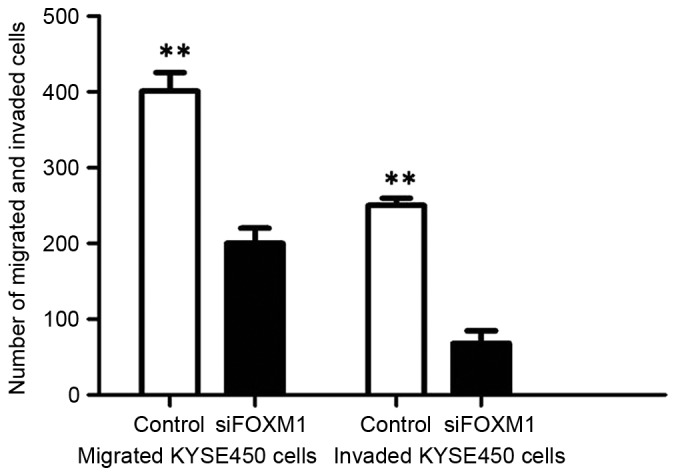
Inhibition of invasion and migration of KYSE450 cells by siRNA treatment of FOXM1. FOXM1, forkhead box protein M1; siFOXM1, short interfering RNA against FOXM1. **P<0.01 vs. control.
Discussion
The majority of patients with ESCC are diagnosed with advanced stage disease and have poor long-term survival rates. The efficacy of current regimens has reached a plateau and further intensification of cytotoxic agents or radiation dose escalation has been demonstrated to be associated with significant adverse side effects. Despite advances in multimodality therapy, the prognosis of ESCC remains poor and the overall 5-year survival is <15%. Similar to other types of cancer, the development of ESCC is believed to be a multiple-step process induced by the accumulation of activation of oncogenes (11). At present, the exact cellular and molecular mechanisms leading to ESCC have not been systematically evaluated. Consequently, the requirement for the development of effective targeted therapies aimed at treating specific mechanisms underlying carcinogenesis are required in order to improve survival.
Previous evidence has revealed that elevated expression levels or activity of FOXM1 is associated with the development and progression of numerous types of cancer (12). FOXM1 is a proliferation-associated transcription factor with important functions in cell proliferation, differentiation and apoptosis. The present study demonstrated that the expression levels of FOXM1 were significantly increased in ESCC tissues compared with in adjacent normal tissues, at the transcriptional and translational levels. The results of the present study were inconsistent with a previous study, which revealed overexpression of FOXM1 in various types of human cancer. Numerous previous studies have demonstrated that a reduction in FOXM1 expression level resulted in inhibition of proliferation in cancer cells and a marked decrease in tumor growth. The present study used siRNA to knockdown FOXM1 expression in the ESCC KYSE450 cell line. The KYSE450 cell line was selected due to its high abundance of FOXM1. Depletion of endogenous FOXM1 significantly inhibited the viability of KYSE450 cells. These results are consistent with the function of FOXM1 in cell proliferation. Knockdown of FOXM1 suppressed cell migration of ESCC in vitro. In the invasion assay and migration assays, FOXM1 siRNA-transfected cells revealed a low level of penetration through the Matrigel-coated membrane compared with the control cells, suggesting important functions for FOXM1 in human ESCC tumorigenesis and distant metastasis. The results demonstrated that FOXM1 has the potential to be a novel therapeutic target in ESCC.
In summary, the results of the present study suggested that FOXM1 mRNA and protein were clearly expressed to a higher degree in ESCC tissues compared with paired para-cancerous tissues. Downregulation of FOXM1 suppressed proliferation of ESCC cells. In conclusion, FOXM1 may act as a novel target for ESCC therapy.
References
- 1.Bray F, Ren JS, Masuyer E, Ferlay J. Global estimates of cancer prevalence for 27 sites in the adult population in 2008. Int J Cancer. 2013;132:1133–1145. doi: 10.1002/ijc.27711. [DOI] [PubMed] [Google Scholar]
- 2.Ferlay J, Shin HR, Bray F, Forman D, Mathers C, Parkin DM. Estimates of worldwide burden of cancer in 2008: GLOBOCAN 2008. Int J Cancer. 2010;127:2893–2917. doi: 10.1002/ijc.25516. [DOI] [PubMed] [Google Scholar]
- 3.Chai J, Jamal MM. Esophageal malignancy: A growing concern. World J Gastroenterol. 2012;18:6521–6526. doi: 10.3748/wjg.v18.i45.6521. [DOI] [PMC free article] [PubMed] [Google Scholar]
- 4.Tejani MA, Burtness BA. Multi-modality therapy for cancer of the esophagus and GE junction. Curr Treat Options Oncol. 2012;13:390–402. doi: 10.1007/s11864-012-0193-5. [DOI] [PubMed] [Google Scholar]
- 5.Raychaudhuri P, Park HJ. FoxM1: A master regulator of tumor metastasis. Cancer Res. 2011;71:4329–4333. doi: 10.1158/0008-5472.CAN-11-0640. [DOI] [PMC free article] [PubMed] [Google Scholar]
- 6.Sun H, Teng M, Liu J, Jin D, Wu J, Yan D, Fan J, Qin X, Tang H, Peng Z. FOXM1 expression predicts the prognosis in hepatocellular carcinoma patients after orthotopic liver transplantation combined with the Milan criteria. Cancer Lett. 2011;306:214–222. doi: 10.1016/j.canlet.2011.03.009. [DOI] [PubMed] [Google Scholar]
- 7.Yu J, Deshmukh H, Payton JE, Dunham C, Scheithauer BW, Tihan T, Prayson RA, Guha A, Bridge JA, Ferner RE, et al. Array-based comparative genomic hybridization identifies CDK4 and FOXM1 alterations as independent predictors of survival in malignant peripheral nerve sheath tumor. Clin Cancer Res. 2011;17:1924–1934. doi: 10.1158/1078-0432.CCR-10-1551. [DOI] [PubMed] [Google Scholar]
- 8.Balli D, Zhang Y, Snyder J, Kalinichenko VV, Kalin TV. Endothelial cell-specific deletion of transcription factor FoxM1 increases urethane-induced lung carcinogenesis. Cancer Res. 2011;71:40–50. doi: 10.1158/0008-5472.CAN-10-2004. [DOI] [PMC free article] [PubMed] [Google Scholar]
- 9.Calvisi DF, Pinna F, Ladu S, Pellegrino R, Simile MM, Frau M, De Miglio MR, Tomasi ML, Sanna V, Muroni MR, et al. Forkhead box M1B is a determinant of rat susceptibility to hepatocarcinogenesis and sustains ERK activity in human HCC. Gut. 2009;58:679–687. doi: 10.1136/gut.2008.152652. [DOI] [PubMed] [Google Scholar]
- 10.Livak KJ, Schmittgen TD. Analysis of relative gene expression data using real-time quantitative PCR and the 2(-Delta Delta C(T)) method. Methods. 2001;25:402–408. doi: 10.1006/meth.2001.1262. [DOI] [PubMed] [Google Scholar]
- 11.Laoukili J, Stahl M, Medema RH. FoxM1: At the crossroads of ageing and cancer. Biochim Biophys Acta. 2007;1775:92–102. doi: 10.1016/j.bbcan.2006.08.006. [DOI] [PubMed] [Google Scholar]
- 12.Ahmed M, Uddin S, Hussain AR, Alyan A, Jehan Z, Al-Dayel F, Al-Nuaim A, Al-Sobhi S, Amin T, Bavi P, Al-Kuraya KS. FoxM1 and its association with matrix metalloproteinases (MMP) signaling pathway in papillary thyroid carcinoma. J Clin Endocrinol Metab. 2012;97:E1–E13. doi: 10.1210/jc.2011-1506. [DOI] [PubMed] [Google Scholar]



